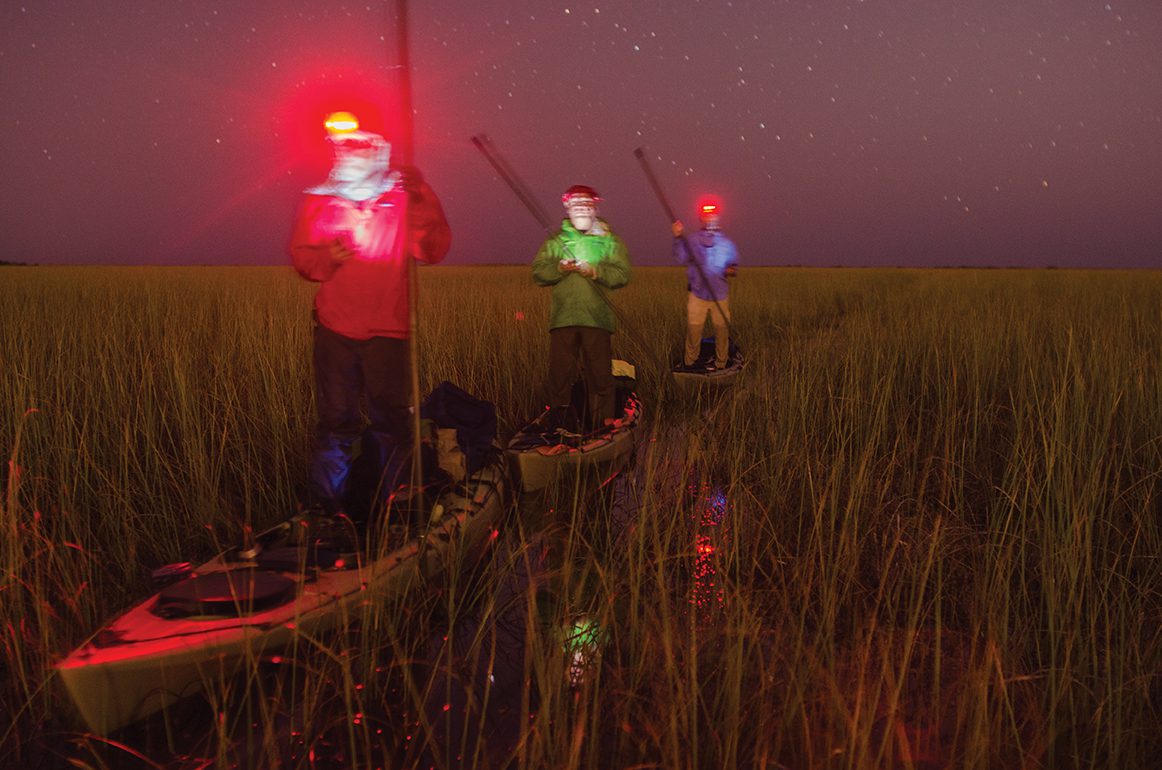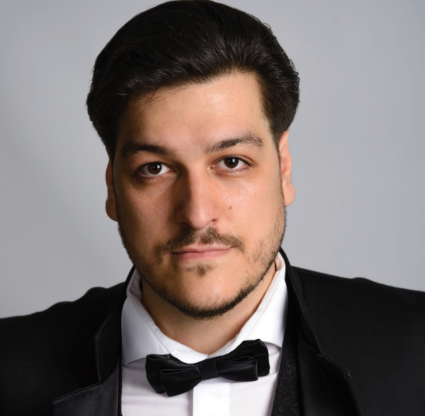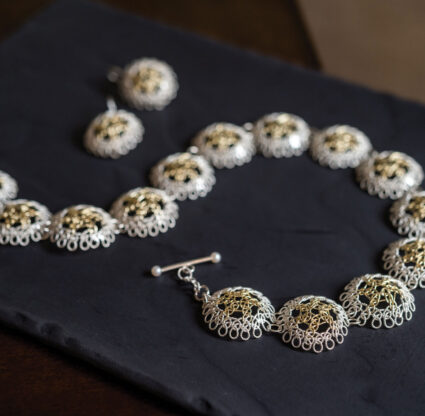I sat in a dark parking lot at the edge of the Everglades, and for the first time it occurred to me that maybe this was a bad idea. The full moon cast an eerie silver light over the deserted asphalt, and the swamp loomed on all sides.
I grew up in Florida, and I’ve spent more time than I can count exploring this state’s natural places. I know the coastlands, the uplands, the streams and rivers. I’ve visited clear springs and salt marshes, scrub prairies and pine forests. I thought I knew every wild spot in the state. Until it occurred to me one night that there’s an entire swath of the natural world I was missing. I didn’t know a thing about the Florida wilderness after dark. Once I got the idea in my head, I discovered that this area has a lot of opportunities to experience nature by night. So I set out to explore as much of the nocturnal terrain as I could.
 |
|
R.J. Wiley took this shot of Corkscrew Swamp Sanctuary during one of its seasonal After Hours events. |
I began with a nighttime pole boat tour through Big Cypress Preserve. Though there are several ways to see Big Cypress and the Everglades at night—including on an airboat—I wanted something quiet and intimate. I hoped to take my time and let the nocturnal world reveal itself slowly, with all its unfamiliar sounds and smells. I booked a pole boat through Everglades Adventure Tours, headquartered in Ochopee, and as I sat in the deserted parking lot surrounded by inky night I hoped my guide would show up before I lost my nerve.
He did, thankfully. His name was Joel, and he had a long beard that was white, maybe, or silver, or even blond. It was impossible to tell. The moonlit landscape was a monochromatic palette of light and shadow where the details blurred at the edges. Joel’s wife, Jacki, had come, too, and though I had an impression of her face, I couldn’t make out her features. How strange, I thought, to spend two hours with people I wouldn’t recognize if I ran into them at Publix.
We drove less than a mile from the parking lot to the put-in point on the Turner River. The light from the moon shone down on the open spaces, but areas beneath bushes and trees were cast in darkness. Jacki and I waited at the boat ramp while Joel went to fetch the pole boat, and it wasn’t long before he paddled into view, standing at the back of a flat-bottomed wooden boat, his pant legs rolled up, the cypress pole he used to propel the boat buried deep in the water. It was a scene straight out of Mark Twain.
We boarded the boat and moved slowly down the river, passing long moments in silence with the moonlight reflecting off the water. We’d entered the nighttime provenance of poachers and orchid thieves. An owl hooted from the bald cypress trees, and beneath the water the fern-like fingers of the aquatic hydrilla brushed against the bottom of the boat, creating a gentle susurrus. The air had a cool, soft quality, and only a few mosquitoes circled my ankles. I had expected the nighttime wilderness to feel threatening; I’d anticipated being afraid. But it had the opposite effect. There was something deeply mesmerizing about that nocturnal landscape, as if all the bracing parts that make Big Cypress difficult to navigate during the day—the sun, the heat, the bugs—had disappeared.
 |
|
A black bear triggers Ward's trail camera. |
But I’m no fool. I know the swamp at night is filled with hidden dangers. For the next leg of our journey, Jacki and I snapped on our headlamps and used their light to shine over the water and along the banks of the river. Before long, the beams caught the yellow eyes of pig frogs hanging suspended in the water.
“The light hypnotizes them,” Joel said. “That’s how people gig them.”
I’d heard stories about my great uncle gigging frogs in these waters. One time he’d miscalculated and speared a water moccasin instead.
We made a slow turn and came back up the river. A swamp chicken clucked irritably from a stand of cat tails, and a pair of limpkins called to each other in their bracing cries. Night-blooming water lilies filled the air with their delicate perfume. Just before a low bridge, Joel stopped the boat. A half-dozen red eyes caught the beams from our headlamps.
“Gators,” Joel said. Baby gators, to be exact. They were no more than a foot long, spread out across the water, looking at us with their unblinking eyes. “Mama can’t be far off.”
We searched the cutgrass near the banks until we found her, 6 feet long with her own set of glowing eyes. We poled silently past, careful not to nudge her babies, gliding back to the put-in point beneath the silver moon.
 |
|
Ward documents a starry-skied morning. |
I’d had a taste of the dark wilderness, and it wasn’t enough. The night after my pole boat tour, I again set out to discover a piece of Florida nature after dark—this time, an area I knew well. The Six Mile Cypress Slough in Fort Myers was hosting a full moon walk to give people the chance to explore the slough’s boardwalks at night. I’d strolled those paths many times in the hot brightness of mid-afternoon with the sun’s rays shining on the cypress trees. This time, I arrived at dusk when the light turns pink and pearlescent. Already, the ibises were roosting in the trees and the birds whose calls normally fill the slough—gnatcatchers and Carolina wrens—had quieted for the evening.
 |
|
Paul Marcellini captures Long Pine Key Lake. |
Thirty people had come for the nighttime walk, and the volunteer guides divided us into groups of six. There was a brief lecture on the moon, this particular one known as the Beaver Moon, and by the time we set out on the boardwalk, darkness was descending. Round patches of white lichen, like daubs of paint against the tree trunks, glowed a ghostly white. The colors of the slough were leached away and replaced by shades of gray and silver, so that I had the impression we’d stepped into a Clyde Butcher photograph. Cicadas and grasshoppers whirred and chirruped from the trees.
We walked without talking, a quiet meditation on darkness and light. The moon cast a silver lozenge across the boardwalk, which we stopped to admire before walking through so that the light slid over our shoulders and backs. We stood for a time at Pop Ash Pond, a place I’d seen in the daylight many times, now ringed by shadows, the outlines of alligator flag silhouetted against the dark. It was odd to be standing with a group of strangers in perfect stillness and quietude, but it felt like the right way to experience a landscape that was at once familiar and vastly strange.
When the walk was complete, our small group stopped and sat on the benches at the entrance to the slough, facing out over Alligator Pond. While we spoke in whispers, a low rumble came from deep in the darkness at the edge of the water.
“Is that a hog?” one woman asked.
We stopped talking and listened.
“No,” our guide said. “That’s an alligator.”
We fell silent, mesmerized, as the bellowing continued from the dark.
“I’ve got goosebumps,” someone said.
I think we all did.
 |
|
The infamous Everglades "Z Tree" captured by Marcellini during a full moon. |
I had one final night of exploration, another full moon walk, this time at the Matanzas Pass Preserve on Fort Myers Beach. The sun was still up when I arrived, but just barely. It drifted toward a horizon obscured by clouds. On this particular night the moon would be at its fullest, but it was impossible to tell with the cloud cover. The twilight had a dusky quality, and the live oaks and cabbage palms were cast in sepia tones. Night seemed to come slowly, slowly and then—when we weren’t expecting it—all at once.
I grew up on the beach, and I know Matanzas Pass well. I know its salt smells, its hot summertime feel, the look and shape of its mangroves. But at night the experience was different. The air still smelled of camphor weed and tidewater, but the scents were muted and more accessible than they are in the daytime, when the onslaught of heat makes sensory observations a strain.
The boardwalk glowed white as we followed our guide, single file, and a second guide brought up the rear.
 |
|
Ward lights up his tent among a stand of longleaf pines. |
“So none of you get lost,” he said.
Both guides carried a single candle in a glass hurricane lantern, enough light to show their presence but not enough to illuminate the landscape. I lost all visual sense for what surrounded me. What was clear only a half-hour before—gumbo limbo tree limbs, Spanish moss, the pneumatophores of mangroves poking out of the muck like fingers—had disappeared into the amorphous dark.
Our group leaned for a time against the railings of a pier, listening to the echoes over Estero Bay, and then we turned back to the boardwalk, our feet pointed toward the parking lot. But I stopped. Deep in the trees, in the darkest hollow where no ambient light reached, I saw a small blue flash. And then another. It looked like—But that’s impossible. I’ve lived in Florida most of my life, and I’d never seen anything like it.
One of the volunteers caught me looking.
“Fireflies,” he confirmed.
We were less than a mile from where I grew up, and here was a miraculous bit of the nighttime wilderness I never knew existed. Florida’s natural places are like that after dark, rich and mysterious with treasures it’s hard to imagine in the light of day.
IF YOU GO
It’s a lot easier to explore the natural world at night than you might think. Here are some options around Southwest Florida for getting out after dark.
If you want to see Big Cypress and the Everglades at night, you might try an airboat tour. Sawgrass Recreation Park has one. But if you like to explore things more slowly, don’t miss a nighttime pole boat tour. Try Everglades Adventure Tours in Ochopee. evergladestours.com, (954) 389-0202; evergladesadventuretours.net, (800) 504-6554
Two of my favorite local nature spots—Six Mile Cypress Slough in Fort Myers and Corkscrew Swamp Sanctuary in Naples—both offer opportunities to explore their boardwalks at night. Check out the slough’s full moon walk and Corkscrew’s after-hours events. sloughpreserve.org, 239-533-7550; corkscrew.audubon.org, 239-348-9151
Matanzas Pass Preserve on Fort Myers Beach holds volunteer-led walks during the full moon. These are small, intimate experiences capped at 12 participants. Contact Jim Rodwell to reserve your space. friendsofmatanzaspasspreserve.org, 239-565-7437
 |
|
Ward paddles behind Elam Stoltzfus in the Caloosahatchee River at sunset. |





